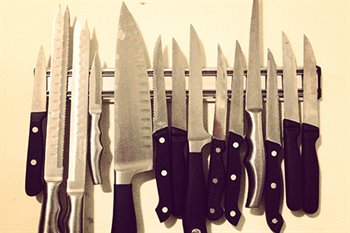
Not all knives are made equal. In fact, certain knives are made for specific purposes. If you find yourself repeatedly cutting an ugly piece of meat - or destroying a stalk of vegetable, even – then you are most probably NOT using the right kind of knife. With that being said, make sure to read on more about the different types of knives – and which you should use for the food you are about to prepare.
Measuring anywhere from 6 to 14 inches long and an inch and a half wide, a chef’s knife boasts of a curve that is more prominent at the tip. This versatile blade was originally created to slice through large meats on a butcher block board, but it’s also versatile enough for slicing herbs and chopping nuts.
A paring knife is perfect for peeling fruits/vegetables, making garnishes, or deveining shrimp. It has a short blade measuring 2.5 to 4 inches long, with an edge that is smaller compared to the trusty chef’s knife.
One of the ‘big blades’ out there is the bread knife, which looks like a bigger, meaner version of the serrated utility knife. It has grooves which allows it to cut through bread cleanly. While the blades are all relatively the same, handle designs vary.
The boning knife’s name holds a clue regarding its purpose – it’s made to separate meat from the bone. It usually comes with a thin yet flexible curved blade that is between 5 to 7 inches in length.
Word to the wise: there are different kinds of boning knives. The ones made with stronger blades are ideal for cutting beef on a butcher block board; while the more flexible knives are intended for deboning chicken. If you see a very bendable boning knife – it is otherwise known as a filet knife, which is perfect for preparing fish.
Some would mistake a carving knife for a chef’s knife, although the former is thinner and much more stretched out. It measures 8 to 15 inches long, with a razor-sharp edge that allows the user to create a thin slice of meat.
Known to many as the cleaver, a butcher’s knife boasts of a thick blade with a sharp, beveled tip. The length ranges from 6 to 12 inches, usually depending on what cut the butcher makes. Because of its immense size, it is often it is used in conjunction with a sturdy butcher block board.
A butcher’s knife is made for separating the meat from the bone, as is the case for pork, beef or chicken. It can also cut through big vegetables (i.e. squash, melon). For smaller tasks, there’s are smaller versions of a butcher knife/cleaver which can be used to dice fruits and vegetables.
This knife has a short blade that is positioned downward. Its name comes from the fact that it can help you perform a tourné cut on root vegetables. Add to that, it also allows you to peel off the skins from your favorite fruits and vegetables.
If you are a self-proclaimed cheese lover, then this blade should be your top investment. This knife comes with perforations that prevents the cheese from sticking to the metal. As for hard cheeses, your best bet is a sharper cheese knife.
Nothing beats having the perfect knife and a high-quality hardwood butcher block board. Check out our various designs, models and species and choose yours today!